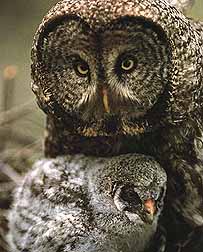Great Gray Owl
Strix nebulosa
(large owl)
 The Great Gray Owl is the largest owl in North America. It has been known to be over 33 inches (84 cm) long from its head to its tail. This massive owl has a large round head with an enormous pale facial disc. Surrounding its yellow eyes are concentric circles. Its beak is light, and it has a black chin spot just above two white feathered mustaches. It lacks ear tufts. This owl's head and back are mottled gray with brown. Underneath, it
is barred dusky gray.
The Great Gray Owl is the largest owl in North America. It has been known to be over 33 inches (84 cm) long from its head to its tail. This massive owl has a large round head with an enormous pale facial disc. Surrounding its yellow eyes are concentric circles. Its beak is light, and it has a black chin spot just above two white feathered mustaches. It lacks ear tufts. This owl's head and back are mottled gray with brown. Underneath, it
is barred dusky gray.
Having a very deep call, the Great Gray Owl makes an irregular series of booming whooos each one lower in pitch. Its call sometimes sounds like whooo, hoo, hoo. Occasionally this owl also makes a single deep whoo.
This raptor lays 2 to 5 white eggs in an abandoned nest. It will usually use a hawk's or crow's nest, and it prefers to be at the top of a tall pine tree or on a cliff side.
The Great Gray Owl is a northern raptor found in the taigas, but it does not usually go as far north as the Hawk Owl. This large raptor lives in the bogs and forests of Canada.
This owl has commonly been seen from Alaska to Ontario. It has also been found from British Columbia to the western United States, but this raptor stays at high elevations in the Sierra Nevada and Rocky mountain ranges. The Great Gray Owl likes the cold and therefore stays in the far north or at high elevations.
Typically hunting during late afternoon, the Great Gray Owl searches alpine meadows, conifer forests, and bogs for prey. It hunts a variety of animals from mammals to avians.
The population of the great gray owl fluctuates with that of small mammal populations. The overall population status of this bird is not known. The great gray owl is basically sedentary; movement occurs when small mammal populations are low, there is heavy snow, or there are high populations due to reproduction success.
Like most northern owls the Great Gray has a remarkably small body surrounded by a deep mass of feathers. In fact it's the feathers of this owl that provides it with insulation and protects it from the harsh cold. This raptor, like the Hawk Owl, is well suited for its rugged environment.
The great gray owl was designated rare in 1979; in 1990, the designation known as rare was changed to a new designation, vulnerable.
The great gray owl is protected, in Canada, through provincial
regulations. In the United States, it is protected by federal legislation.
 The Great Gray Owl is the largest owl in North America. It has been known to be over 33 inches (84 cm) long from its head to its tail. This massive owl has a large round head with an enormous pale facial disc. Surrounding its yellow eyes are concentric circles. Its beak is light, and it has a black chin spot just above two white feathered mustaches. It lacks ear tufts. This owl's head and back are mottled gray with brown. Underneath, it
is barred dusky gray.
The Great Gray Owl is the largest owl in North America. It has been known to be over 33 inches (84 cm) long from its head to its tail. This massive owl has a large round head with an enormous pale facial disc. Surrounding its yellow eyes are concentric circles. Its beak is light, and it has a black chin spot just above two white feathered mustaches. It lacks ear tufts. This owl's head and back are mottled gray with brown. Underneath, it
is barred dusky gray.